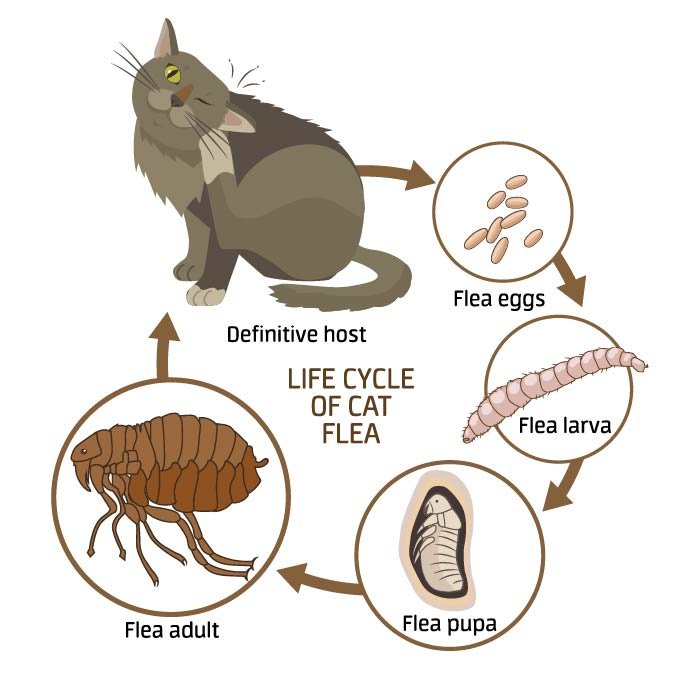You go to cuddle with your indoor cat and notice what looks like salt and pepper on your white shirt. Since you’re a scientist at heart and want to know exactly what those specks are, you shake them off onto a white paper towel and add a drop of water. Oh no! The black specks dissolve into pink. You found flea eggs and flea feces.
Alternatively, you may have rolled your cat over in your lap and noticed tiny brown insects running across her groin area. Or you may notice your cat scratching and biting at herself. A rash around the tail head or groin areas can mean fleas. How could this be? Your cat does not go outside!
A Flock of Fleas
Fleas are more than a nuisance. They can carry diseases that could not only infect your cat but could also make you ill if you get bitten. One such example is plague, caused by the bacterium Yersinia pestis, which can be transmitted by fleas, primarily in the western United States. Fleas can also spread parasites, such as tapeworms (see “Does Your Cat Have Parasites?” in our February 2018 issue, available at catwatchnewsletter.com).
The most likely culprit as the source of fleas is other pets. If your dog goes outside in the yard, he may have brought in some fleas. If your kids bring the pet bunny—who normally resides in a lovely hutch outside—in for a play session, fleas may join the party. The next likely flea transporter is wildlife. While we think of mice getting into old farmhouses, any house can have an invasion. These rodents not only destroy things, but they may bring in fleas that may decide they like your place and jump off to stay.
Humans can bring fleas in from outside, too. If you were out working in the garden, clearing brush, or taking a long walk, it is possible you picked up a flea hitchhiker or two. It’s possible for a cat to pick up fleas at the grooming salon or veterinary clinic. These places are cleaned so frequently that it’s unusual for a flea to survive, but one determined flea may have made its way to your cat.
The most common flea found on cats is Ctenocephalides felis. Fleas may have preferred hosts, but they are equal opportunists if a warm body comes by. If you find one flea, you must assume there are more. That means all your pets who come inside need to be treated.
Flea Wars
Think of dealing with flea infestations as going to war. You need to fight your battles on multiple fronts. Start with your cat. Ideally, she should have a bath with a flea shampoo. That removes and kills any adult fleas on her and will get rid of the flea eggs on her coat. Be sure to bathe all pets that come into the house.
You also need to follow up, so more fleas don’t move to your cat once she is flea-free. This usually means some type of topical medication. Be sure to use products specifically approved for cats. Follow directions exactly as labelled. There are excellent once-monthly topical treatments available. Regular grooming with a flea comb will let you know if more fleas have hatched or moved in.
Killing off the adults found on your cat is merely the first step. There are undoubtedly eggs and larvae in your house. Favorite sites for larvae are in carpets and under furniture. Pupae (the developmental stage after larvae) are commonly found in similar locations. After approximately eight days, the pupal stage metamorphizes to an adult flea, which is stimulated to seek a blood meal from a host by sensing movement, carbon dioxide, and the warm body temperatures of mammals. The pupal stage can survive for months under the right conditions, waiting for the “right” stimuli to hatch.
Your cat is now covered, but you still need to treat the environment—in this case, your house. You have many options. You can hire an exterminator, making sure they are aware that you have pet cats. Your cat will probably need to leave for the day. (Hint: Coordinate her flea bath with the exterminator’s visit.)
You might choose to use do-it-yourself “flea bombs.” Frequent vacuuming will snatch up many fleas. Replace the vaccum bag after treatment.
Diatomaceous earth can be sprinkled around the house. If you use diatomaceous earth get regular, not pool, grade. Some people and pets may react to the fine dust, so try a small area first. Borax can also be used. These products can be vacuumed up or left in place for a bit, depending upon your living situation.
Essential oils are not recommended for use on cats. Many are toxic, and even nontoxic oils can cause feline skin irritation. (See April 2018 “Are Essential Oils Safe For Your Cat?” at catwatchnewsletter.com.)
Flea control is not a quick battle, especially if you have multiple pets and some that go outside. This war may go on for months, especially with a heavy flea infestation.


kotjarko | Adobe Stock
Cat Flea Products
Choose only products labeled as safe for cats
Careful use of pyrethrins can be safe in cats—not so with permethrins! Pyrethrins are natural extracts from chrysanthemums, while permethrin is the synthetic version of pyrethrin. Permethrin is not safe for cats, and some cats may react to pyrethrin, too.
Insecticides are what you need to kill the fleas. Examples of insecticide chemicals that are generally safe for cats include dinotefuran, fipronil, imidacloprid, and nitenpyram.
Insect growth regulators, along with an adulticide, may be helpful. IGR ingredients include s-methoprene and pyriproxyfen.
Cats have a unique system for metabolizing many drugs. Instead of using liver enzymes called glucuronosyltransferases, which are deficient compared to dogs and people, cats tend to oxidize drugs. Never use “dog only” medications for your cat! Be careful, too, to look for the age recommendations on the product packages. Most cat flea products state that they are safe for cats eight weeks old and older. Always follow recommended dosages.




